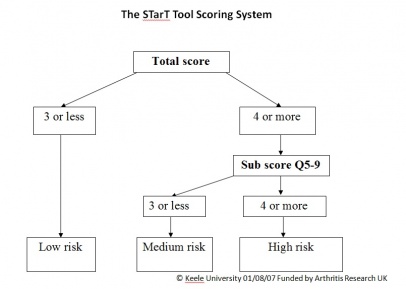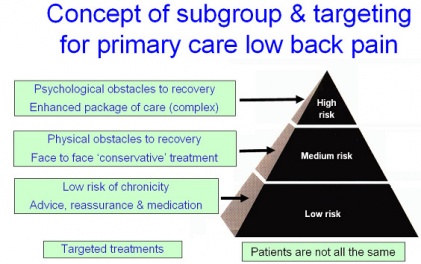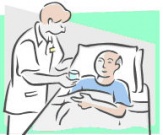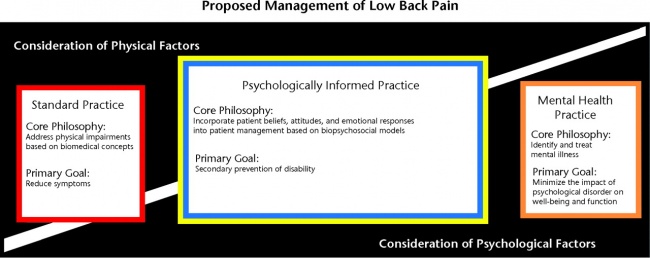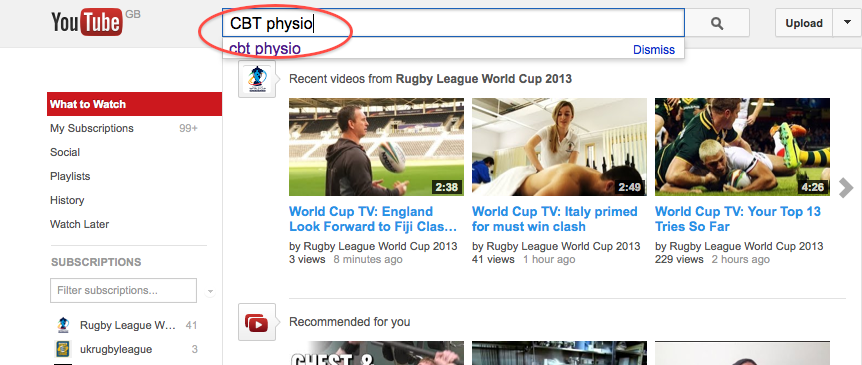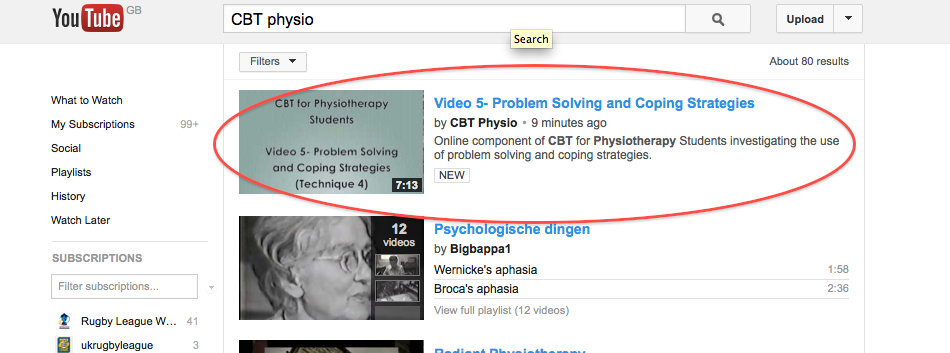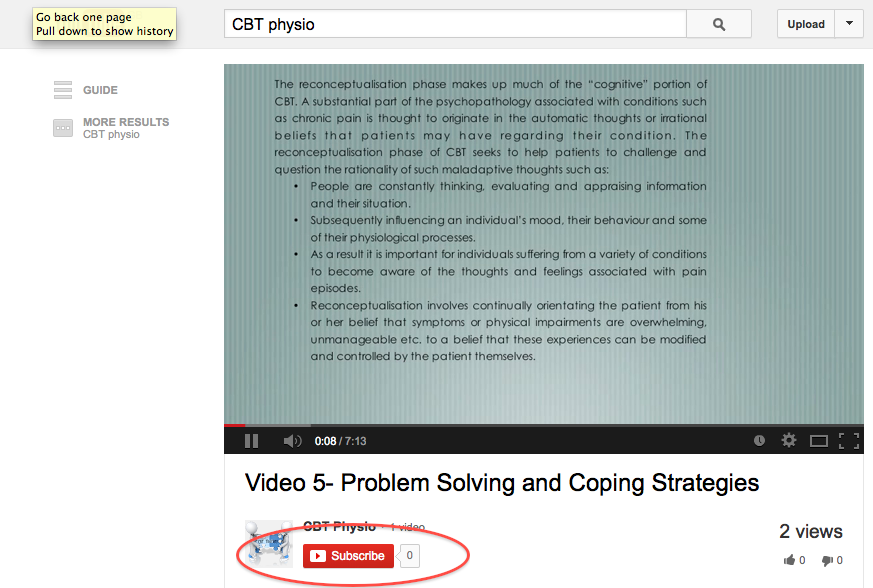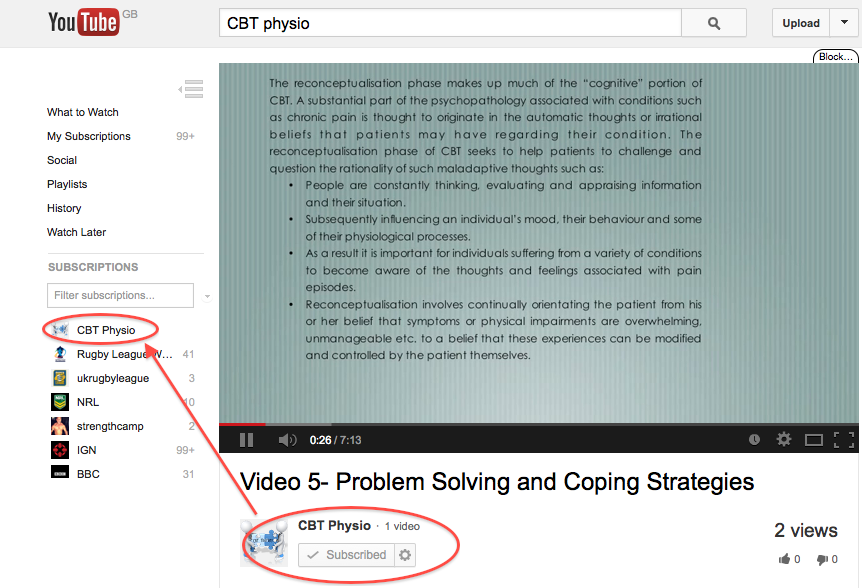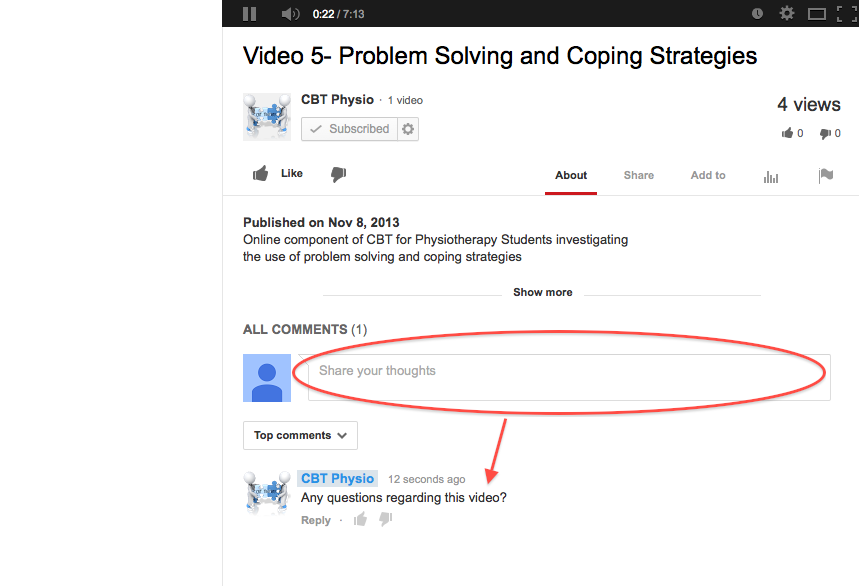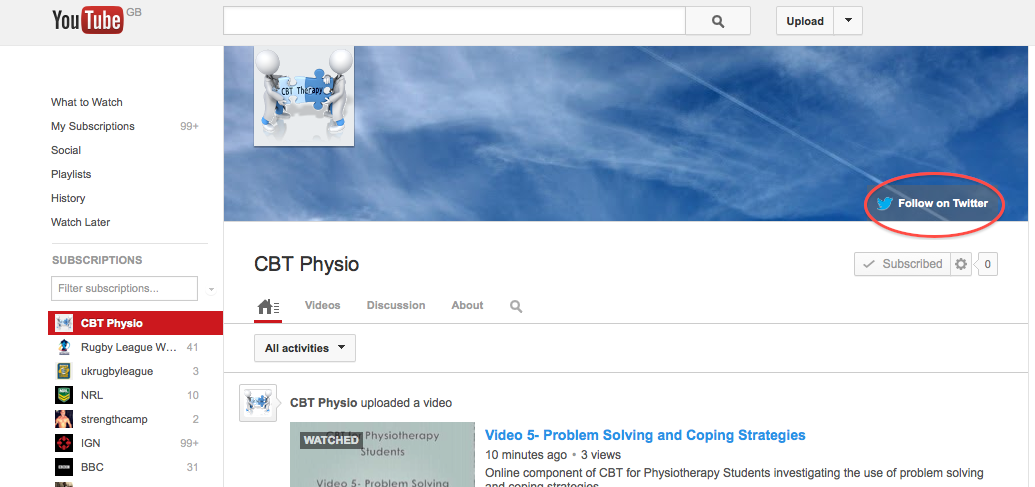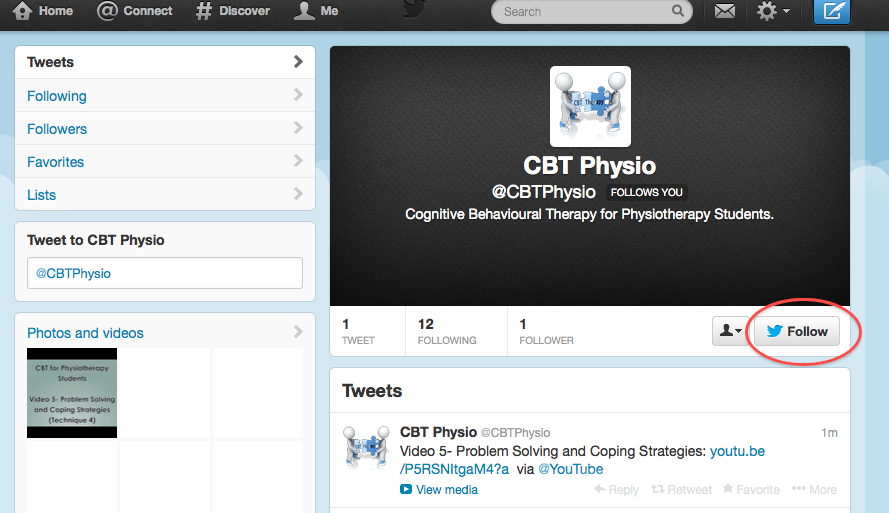The Inclusion of CBT in Physiotherapy Education: Difference between revisions
No edit summary |
No edit summary |
||
| Line 322: | Line 322: | ||
|} | |} | ||
=== Why we are choosing this delivery method of CBT training === | === Why we are choosing this delivery method of CBT training === | ||
The online component of the CBT for Physiotherapy Students section will be available via the video hosting website, YouTube. YouTube is a free to use, internationally available format that allows videos to be searched for, saved, discussed and easily linked to others. YouTube is accessible on an array of platforms such of laptops, tablets and smartphones, which are vital in the ever-changing landscape of personal computing. YouTube commands one of the biggest audiences in terms of Internet traffic in the world with an estimated 100 million unique viewers each month [1]. <br>As a result of YouTube’s search and subscription feature it will be very easy for student to find the “CBT Physio” videos and then subscribe to the channel to remain up to date. To make accessibility to the content of YouTube channel more effective there is the facility for individual users to receive email notifications of new videos and a Twitter account to allow videos and new from module to appear on their social media feed. Twitter is second most accessed social media site (behind Facebook) with over 6 million external sites linking to it (Link Root Domains) [2]. | The online component of the CBT for Physiotherapy Students section will be available via the video hosting website, YouTube. YouTube is a free to use, internationally available format that allows videos to be searched for, saved, discussed and easily linked to others. YouTube is accessible on an array of platforms such of laptops, tablets and smartphones, which are vital in the ever-changing landscape of personal computing. YouTube commands one of the biggest audiences in terms of Internet traffic in the world with an estimated 100 million unique viewers each month [1]. <br>As a result of YouTube’s search and subscription feature it will be very easy for student to find the “CBT Physio” videos and then subscribe to the channel to remain up to date. To make accessibility to the content of YouTube channel more effective there is the facility for individual users to receive email notifications of new videos and a Twitter account to allow videos and new from module to appear on their social media feed. Twitter is second most accessed social media site (behind Facebook) with over 6 million external sites linking to it (Link Root Domains) [2]. | ||
<br>An overview of how the module YouTube Channel will work | <br>An overview of how the module YouTube Channel will work | ||
1. By going to www.youtube.com the user will be able to freely access the video sharing website.<br> | |||
[[Image:1. youtube.png]] | |||
<br> | |||
2. Entering "CBT physio" will initiate a search of all relevent videos.<br> | |||
[[Image:2. youtube.png]]<br><br> | |||
3. The top result is our sample clip.<br> | |||
[[Image:3._youtube.png]]<br> | |||
[[Image: | |||
4. The user can easily subsribe the the channel to recieve updates and to be notified when new videos are published. | |||
[[Image:4._youtube.png]] | |||
5. The chanel will then be added to the users list of subcriptions. | |||
[[Image:5.youtube.png]] | |||
6. Below the video is a comment section for both the user and publisher to discuss the video content. | |||
[[Image:6.youtube.png]] | |||
7. From the channels home page the user can access the corresponding Twitter account. | |||
[[Image:7.youtube.png]] | |||
8. The Twitter account can be followed with a click of button ensuring the user is updated and informed of activity. | |||
[[Image:8.youtube.png]] | |||
9. Any updates from the Module are then fed directly to the users Twitter timeline with direct links to the video. | |||
[[Image:10.youtube.png]] | |||
== | == | ||
Revision as of 20:52, 8 November 2013
Original Editor - Ernest Chao, Florence Cook, Aoife Doyle, Martin Lanfear, Corey Hafner as part of the QMU Current and Emerging Roles in Physiotherapy Practice Project
Top Contributors - Ernest Chao, Corey Hafner, Aoife Doyle, Martin Lanfear, Florence Cook, Kim Jackson, Admin, 127.0.0.1 and Evan Thomas
A proposal to the HCPC for the inclusion of a Cognitive Behavioural Therapy workshop to enhance the skills of new physiotherapy graduates
[edit | edit source]
Learning Outcomes:[edit | edit source]
- Critically appraise the importance of CBT in physiotherapy practice for the benefits of new physiotherapy graduate.
- Formulate an appropriate CBT in-service that enhances the ability of graduate physiotherapists to address the psychosocial aspects with regards to patients in various settings
Part 1: Theory[edit | edit source]
History of Cognitive Behavioural Therapy (CBT) [edit | edit source]
COREY
In the early 1960s psychoanalyst professor, Aaron Beck developed cognitive therapy after investigating the psychoanalytic concepts of depression (Beck 2011). During his studies, he discovered that depressed patients spontaneously experienced automatic negative thoughts (Beck 2011). These negative thoughts fell into three categories: negative thoughts about themselves, the world, and the future (Donaghy et al. 2008). After spending some time with these patients Beck recognized that these automatic negative thoughts were highly related to the individual’s emotions. Beck started to notice rapid improvements amongst these individuals after helping these patients identify, evaluate and respond to their maladaptive thinking and behaviour patterns (Beck 2011). In order to see the effects of this form of cognitive therapy, a randomized control study was conducted looking at the impact of cognitive therapy in depressed patients (Beck 2011). Results showed cognitive therapy to be as effects as imipramine, an antidepressant (Beck 2011). These findings were a huge milestone, as a form of talk therapy had been compared to a pharmacological medication (Beck 2011). Today CBT has been scientifically proven to be effective in numerous clinical trials for varying disorders (Beck site).
What is CBT?[edit | edit source]
Cognitive behavioural therapy stems from the cognitive model of psychopathology (Beck 2011). This theory looks at how individual’s perceptions and thoughts about situations influence their emotional, behavioural and physiological reactions (Beck site). For example when individuals are stressed their thoughts tend to be distorted and dysfunctional, if individuals learn to identify and address these thoughts thus correcting them, there stress tends to decrease and they will be able to behave more functionally. INSERT DIAGRAM
Cognitive Behavioural therapy teaches individuals to confront their irrational thoughts, in a more realistic and adaptive manner so that they experience improvements in their emotional state and behaviour (Beck 2011). CBT can include a number a cognitive and behavioural techniques including self-instructions (i.e. imagery, distraction, motivational self-talk), the use of relaxation and biofeedback strategies and adaptive coping strategies (i.e. minimizing self-defeating thoughts) (Gatchel et al. 2007). INSERT DIAGRAM. CBT involves 6 overlapping phases that can be adapted to a diverse set of populations with various disorders and problems (PAIN). The phases represent the different theoretical components of the multidimensional treatment. Even though CBT follows a logical sequence, the treatment should be flexible and individualized to the patient’s needs.
6 phases of CBT (PAIN: churchill)
[edit | edit source]
- - PHASE 1: ASSESSMENT
- This phase involves assessing information given from the patient and family through a series of self-reported measures and observational procedures to identify the degree of psychosocial impairment
- o Information provided determines the most appropriate course of action
- o Establish baseline measures
- - PHASE 2: RECONCEPTUALIZATION (“cognitive” portion of CBT)
- o Patients are often asked to maintain a self-report diary
- o Seeks to help patients challenge and question their maladaptive thoughts (i.e. “I am a failure in life because I am in pain”)
- o Collaboratively set goals with the patient
- - PHASE 3: SKILLS ACQUISITION AND CONSOLIDATION
- o Therapist use various cognitive and behavioural strategies to teach the patient how to deal with obstacles in their day to day lives
- o Collaboratively focus on problem solving strategies (i.e. relaxation techniques/coping strategies)
- - PHASE 4. SKILLS CONSOLIDATION AND APPLICATION
- o Patient are given homework to help reinforce the skills that they have learned
- - PHASE 5: GENERALIZATION AND MAINTENANCE
- o Patient reviews homework and practices skills that have been taught, they considers potential problematic situations that may arise
- o Patient evaluates their progress and attributes success to their own coping efforts
- - PHASE 6. POST-TREATMENT AND FOLLOW-UP
- o All aspects of therapy are reviewed
- o Therapist monitors and evaluates patients application of CBT to their live
How and why does cognitive behavioural therapy fit into physiotherapy practise? [edit | edit source]
Cognitive behavioural therapy (CBT) is a technique that is used to alter the way a person thinks about their issues and therefore how they can change their behaviour to manage your problems. We are proposing that the correct implementation of CBT by physiotherapists, within our scope of practise, would increase the success of treatment and overall outcome of interventions for patients.
Here is a table that illustrates the fundamental principles of both CBT and physiotherapy and how they are relatable#
| Cognitive Behavioural Therapy | Physiotherapy |
| Identification of current and specific problems | The synthesis of a problem list |
| The use of goal setting | The use of SMART goals |
| The treatment is both individualised and collaborative between therapist and patient | Patient centred care |
| Aims to uncover and change behaviours and schemas | Correcting bad habits and uncovering why the bad habits have occurred in the first place |
| Aims to build CBT skills to prevent relapse | Focus is on self management |
CBT aims to provide belief for the patient to conquer their issues. This allows them to regain locus of control to influence the patient’s specific problem. Physiotherapists are in a prime position to help manage and create the patient’s belief. The start of any physiotherapy assessment begins with a subjective examination. This provides the opportunity for physiotherapist to gauge if CBT would be an appropriate tool for the patient. If physiotherapists were given the appropriate tools to spot yellow flags early on this would allow them to incorporate these problems into the patient’s treatment plan. It may be argued that Physiotherapists are the most effective member of the MDT to deliver this level of CBT due to the amount of contact time between the physiotherapist and patient further providing a more successful treatment.
The physiotherapist’s experience and knowledge can be a great aid in administering CBT because it allows them to speak with authority, about successful cases that have over come specific problems. This is particularly effective if the previous successful case is similar to the current issue. This helps the patient to create belief that they will be able to succeed, therefore making them more compliant, enhancing success and preventing the development of learnt helplessness and negative behaviour patterns.
CBT will be a useful tool to help increase the success rate of various complex cases, as it treats the problem at the root and helps to prevent the patient from returning to their maladaptive behaviours. The structures of CBT and physiotherapy are comparable and integrate cohesively with one another. For example, problems are identified at the beginning of the session, a treatment plan and goals are agreed upon between patient and therapist. In this sense a CBT issue could be identified and worked into the treatment plan quite seamlessly. This would mean that the idea of CBT would not feel so daunting because the treatment would be woven into the usual physiotherapy session. With the incorporation of CBT into the treatment plan, the patient would not feel as though they are receiving a psychological treatment, making the problem easier to tackle. Thus, individual’s who would not have ordinarily agreed to a full course of CBT are able to benefit from this type of therapy.
Therefore, amalgamation of CBT into our current training would provide physiotherapists with the skills to spot and treat yellow flags early preventing the need for a referral to a clinical psychologist. By preventing this issue at the start may decrease contact time amongst the multidisciplinary team further decreasing health costs. It would also give physiotherapist’s the skills to pick up and treat subtle yellow flags, therefore preventing people from slipping through the net and developing and enhancing their bad habits. This would have the potential to increase the success rate of treatment and cut down on future visits, as the patient would learn to self manage their behaviours.
Aoife and Ernest [edit | edit source]
There is empirical evidence that Cognitive Behavioural Therapy (CBT) is effective in improving problems such as anxiety, depression, post-traumatic stress disorder, eating disorders and chronic pain. In the United Kingdom, the National Institute for Health and Clinical Excellence (NICE) recommends CBT as the treatment of choice for a number of mental health difficulties previously mentioned (London Bridge Physiotherapy). In addition, there is a growing body of evidence behind the effectiveness of cognitive behavioural therapy (CBT) for physiotherapy producing significant improvements for patients with back pain[1], chronic pain[2] and fibromyalgia [3] with regards to function, pain experience and coping strategies.
INSERT BOX OF CONDITIONS
Which Patient Population Does CBT Work For?[edit | edit source]
The therapeutic alliance between the patient and the therapist is an important aspect of the CBT and involves a collaborative approach from the therapist and active participation from the patient. CBT is widely applicable across situations and beyond the initial problem for which the patient may seek treatment, though it has been specialized and adapted for use within a number of specific disorders ranging from depression, anxiety, and insomnia, to substance abuse and psychosis. CBT has also become increasingly popular for a wide variety of chronic pain conditions, particularly for chronic LBP (Sveinsdottir et al. 2012).
Despite this, there exists a patient population that is less likely to respond to CBT as a treatment[4]. In addition, some research has shown that a CBT approach is no more effective at reducing pain levels as traditional interventions [5]. Perhaps a more systematic approach to matching the treatment to certain patient populations and filtering CBT to those who are more likely to respond positively to treatment is the approach required for CBT.
The Keele STarT Back Screening Tool (SBST) is designed to address the mismatch. A sample MSK screening tool. The SBST categorizes patients with low back pain into three subgroups based on their prognosis (low risk of chronicity, medium risk with physical obstacles to recovery, and high risk with psychological obstacles to recovery) [1]. The practice of physiotherapy revolves around patient centered care. The choice of a physiotherapist utilizing CBT as an intervention stems from prior CBT training, therapist intuition and determining from a tool such as the SBST, whether there would be a mismatch between whether a patient will need and respond well to CBT. The SBST is valid and repeatable, and consists of 9 items which include: referred pain, co-morbid pain, disability, bothersomeness, catastrophizing, fear avoidance, anxiety and depression. The latter 5 items combine to form a subscore relating to psychosocial factors that indicates appropriateness for CBT as an intervention[2]. The SBST is currently being adapted to musculoskeletal conditions, with trials occurring in the NHS 24 in Scotland[1].
Targeting patient subgroups that are most likely to be receptive to CBT can help improve outcomes and reduce costs. A trial of SBST conducted by Hill et al. 2011[3] demonstrated increased health benefits along with reduced cost of health care. The trial revealed that with the SBST and trained therapists to deliver targeted interventions for each of the three subgroups of patients, there was a direct mean savings of £34.39 per patient and an indirect productivity of £675 per patient when compared with patients receiving best current care. Pain-related productivity and societal losses can manifest with an increase in sick leave days and number of health care visits for back pain. A randomized control trial conducted by Linton et al. 2005[4] found that CBT in addition to physiotherapy reduced the mean number of health care visits due to pain from 6 to 1, and reduced the percentage on sick leave from 9-14% to 2-5% when comparing groups that received minimal treatment and CBT. This type of evidence suggests that with therapeutic interventions that take into account the biopsychosocial model of patient care, there is a possibility to reduce disability and reduce the cost of care.
The evidence in the literature is indicative of the effectiveness of CBT when directed at the correct patient populations. Current practices are implementing CBT as an approach. Tools like the SBST need to be used in conjunction with sound clinical reasoning in a patient centered approach to target those who are likely to benefit from it. With adapted versions of the SBST to encompass other musculoskeletal conditions being trialed with the NHS 24 currently, newly trained physiotherapists would benefit from CBT training to effectively utilize this new information gained from patients in practice. Physiotherapists are evidenced-based practitioners and there exists not only a need for further training to incorporate CBT principles, but a desire to expand knowledge on CBT principles from practicing physiotherapists as well[5].
Examples of the use of CBT in various patient population i.e. Acute, Chronic, Mental Health etc.
[edit | edit source]
There has been an increase in the demand for interventions that may prevent the development of persistent pain problems.
In 1997, Waddell at el. reviewed 10 trials of early interventions for acute back pain mainly in primary care settings. These programmes dealt with fear and anxiety which is often associated with acute pain leading to positive results over various control conditions. Von Korff et al. (1998) also found that a cognitive-behavioural programme for patients with acute back pain significantly reduced worry and disability at follow-up – therefore preventative measures may be viable.
In 2001, a RCT was published which aimed to investigate the preventative effects of a CBT group intervention for people reporting neck or back pain (Linton and Ryberg. 2001). The participants had experienced four or more episodes of relatively intense spinal pain during the past year but had not been out of work more than 30 days. As a result the aim was to prevent a non-patient population developing a more serious pain problem and entering a chronic stage. The experimental group participated in a six-session structured programme where the individuals met in groups of 6-10 people once a week for two hours. The CBT group showed the most stable improvements over the control group with a better result for sick leave, reducing the risk of sick leave greater than 2 weeks by more than threefold. The CBT group also reported a decrease in fear avoidance and an increase in the number of pain-free days concluding early preventative measure may be helpful.
With regard to the issue of sick leave and absenteeism, musculoskeletal disorders are one of the most commonly reported work-related illnesses (Jones et al. 2003). There is now general agreement among the various occupational health guidelines for management of MSDs which encompasses the identification of psychosocial obstacles to recovery, provision of advice that MSDs are self-limiting conditions and that remaining at work or an early return to work (RTW) should be encourages and supported.
A study was conducted in 2006 in a large pharmaceutical company in the UK. Occupational health nurses were trained to deliver an intervention to workers taking absence due to various MSDs including low back pain and upper limb disorders. This training package included education about pain and pain mechanisms, tackling negative beliefs and attitudes and reinforcing the importance of keeping active and early RTW (McCluskey et al. 2006). Results showed a decrease in absence days in one particular site compared to the control site where workers were seen by the OHN on RTW. In summary this study adds to emerging evidence that absence from work can also be reduced by providing information and support to employees.
CBT has also been used successfully with angina patients (Lewin et al. 1995)
The Heart Manual in particular is a six-week cognitive behavioural rehabilitation tool for use in the immediate post Myocardial Infarction (MI) period. Developed from the Health Belief model, the programme is designed to correct misconceptions about the cause of heart attack and at the same time to help patients develop strategies for dealing with stress, in order to neutralise enduring misconceptions. The Heart Manual is one way of providing educational and psychological support for post MI patients, although it will not meet the needs of a minority who require additional help.
The initial randomised controlled trial evaluating the Heart Manual found that those receiving the manual had improved emotional states and fewer GP contacts and hospital readmissions at six months post MI (Lewin et al. 1992). Subsequent studies have found significantly fewer readmissions in treated patients77 and improvement in emotional state and sense of control at six months (O’ Rourke and Hampson, 1999).
As previously mentioned, CBT can also play a role in the treatment of various mental health conditions. A study was published in 2002 (Lewis et al) which aimed to test the effectiveness of added CBT in accelerating remission from acute psychotic symptoms in early schizophrenia. A 5-week CBT programme plus routine care was compared with supportive counselling plus routine care and routine care alone in a multi-centre trial randomising 315 people with DSM-IV schizophrenia and related disorders in their first (83%) or second acute admission. Linear regression over 70 days showed predicted trends towards faster improvement in the CBT group concluding that CBT shows transient advantages over routine care alone or supportive counselling in speeding remission from acute symptoms in early Schizophrenia.
MARTIN (CBT IN MDT AND FAMILY)
[edit | edit source]
Cognitive behaviour therapy can also be used away from the therapist-patient relationship. Some areas where CBT can be applied by an AHP include:
• Supporting families of those with both chronic and acute conditions:
o Reassurance to family member of those affected by both chronic and acute conditions is essential in the treatment and recovery of the patient [9].
o Programs designed to include families in the care of relatives with chronic conditions can be implemented, particularly in the chronic/terminal setting. Such programs can guide family members in setting goals for supporting patient self-care behaviours, train families in supportive communication techniques and give families tools and infrastructure to assist in monitoring clinical symptoms and medications [10].
o For those with career threatening injuries e.g. professional athletes or manual working, coping with potential loss of income can be extremely stressful for both themselves and their families.
In order to get families on board in a supportive role, there often needs to be a change in cognition. Unrealistic and irrational thoughts regarding their loved ones prognosis may be detrimental to the treatment process, therefore where possible such beliefs should be addressed to reduce the potential of any maladaptive behaviours [11]. For those with acute conditions that may result in loss of earnings or concept of self, CBT may help to prevent anxiety and cognitive distortion e.g. catastrophizing as well as increased adherence to rehabilitation protocol [12].
• To work effectively other members of the Multidisciplinary Team (MDT), particularly in challenging settings e.g. palliative care, oncology, pediatrics:
o When those working in palliative care settings have been interviewed with regards to work place stressors more were related to difficulty with colleagues, work environment, and occupational role than with interaction with patients and their families [7].
o Seeking support from colleagues is often preferred and more accessible then official support models in place for those working in health provision areas with high stress [8].
With an insight into the cognitive and behavioural components of our own actions we can develop higher self-monitoring traits along with increased empathy, this in turn may lead to further understanding of fellow professionals within the MDT thus enabling us to defuse any potentially volatile situations. Furthermore, many of the environments in which Physiotherapist’s skills are required a highly stressful and emotional. As a result we may be required to engage in supportive behaviour and cognitive reason with colleagues.
• To ensure an optimum personal mental health for AHP’s:
o The Health and Safety Executive (HSE) recognizes that there are many factors in the workplace that contribute to strains on NHS professional’s mental health. These include: excessive demands, lack of control, lack of support, poor working relationships, role ambiguity, organizational change [1].
o The 2009 Boorman Review reported that the NHS 10 million working days annually due to sickness costing the NHS an estimated £555million, with mental health along with muscular skeletal issues being the primary cause. Combined they are also the leading cause of health-related early retirement in the NHS [2].
o The Work Foundation estimates that presenteeism due to poor mental health leads to a loss of working time nearly 1.5 times that caused by sickness absence due to mental health in the United Kingdom [3].
By having an understanding of ones own cognitive, allied health professionals may be able to overcomes the inherent stresses of their jobs. It has been documented that self-directed CBT can reduce an individual’s own stress, anxiety, depression and cognitive dissonance [4][5]. As CBT incorporates the introspection of thought process from Cognitive Therapy and the goal of behavioural change from Behavioural Therapy, CBT can be a useful tool for Physiotherapists in their own development as a competent and holistic professional [6]. The resultant increased insight into their thoughts and ability to rationalize those that are irrational in nature may lead to a reduction in mental health issue in those that work on the NHS, resulting in a decrease in work days lost.
Part 2: Case Studies [edit | edit source]
Sample case studies where CBT can be beneficial
Principles to CBT treatment
- Therapeutic Alliance
o Essential that the patient views therapy as teamwork
o Important for the therapist to provide empathy, warmth and genuine regard, through listening and understanding the patients true feelings
o Providing a realistic outlook
o Ensuring the patient understands and agrees with types of therapy
o Active participation from the patient, encouraging the patient to take an active role in her recovery, providing therapy homework
- Goals
o Elicit SMART goals from the start to ensure the patient understands what they are working towards
- Educate
o The therapist should aim to teach the patient skills and techniques of how to be their own therapist
- Time Limited
o Patients are usually treated for 6-14 sessions, the therapist aims to provide relief, resolve the patients most pressing problem and teach them skills to avoid relapse
- Structured therapy
o In order to maximize efficiency and effective each session should be structured
- Various techniques
o CBT uses various techniques to change in order to cater to the individuals needs
- Identify, evaluate and respond
o Patients can have hundreds of automatic thoughts everyday but it is important that the therapist teaches the patient how to identify the key cognitions and how to respond
Case 1: Eager/hyperactive patient and Chronic engraved behaviour[edit | edit source]
Subjective examination:
A 38 year old plumber presents with an 18 month history of low back pain. He’s had
a sore back “on and off” for the past 10 years (about 2-3 episodes a year). These previous episodes would usually resolve within a week or so. However, over the last 18 months, the pain has become constant and he is finding it much, much harder to work because of it. His main problems at work are bending down, working in cramped places (e.g. under sinks), carrying his tools and driving for longer than half an hour. His only (partial) relief is a long, hot bath at the end of the day – it doesn’t help the pain much, it just helps him to relax. He’s self-employed and has a family to support, so he tends to “push on” to get the work done but towards the end of the day, he says he’s “good for nothing except lying on the sofa”. He also spends a lot of the weekend resting to try and recuperate/prepare for the week ahead. His GP has prescribed various painkillers over the last year, none of which have helped much. His GP told him he doesn’t need an XR, a scan or surgery. He attended physiotherapy a year ago where he was given exercises to do and manipulation but none of this helped. He found the exercises very painful to do and so he stopped them because they weren’t helping anyway.
Physical examination:
All active movements of the lumbar spine reduced to about ¾ of normal range. Neurological examination is normal. Palpation of the lumbar spine reveals pain and tenderness at all levels. SLR was 70 bilaterally.
Possible strategies to employ:
Pacing strategies
- At work
- With exercises
Education re: Boom/bust model
Pain management techniques
Case 2: Acute MSK condition
[edit | edit source]
Subjective examination:
A 26-year-old professional rugby player reports coming off his first right ACL-repair. 8 months prior he had his first traumatic injury in a game, when a player tackled his right knee forcing it into valgus. He heard an immediate “pop” and had pain with immediate swelling and immediately went to A&E. An MRI revealed a triad injury of the right knee (ACL rupture, MCL tear, medial meniscal tear). He has had an arthroscopy 4 days following the incident. Since then, he reports he has received daily physiotherapy, but has not returned to rugby since he reports ongoing weakness in his right knee, and feels very fearful of re-injury and returning to the full contact nature of the sport.
Physical examination:
No swelling, locking, crepitus, giving way
All ligaments of knee intact
Full ROM, full strength
McMurrays test negative
Possible strategies to employ:
Graded exposure- progressively increase the amount of full sprints and cutting movements
- Non-contact in training
- Controlled contact in training
- Gradually increasing minutes played in actual game
- Thought re-evaluation
- Re-model maladaptive/fear avoidance behaviors
- Problem solving
Case 3: Palliative care
[edit | edit source]
Subjective examination:
45 year old woman with end stage lung cancer, lives at home with husband and 12 year old daughter. Patient has been managing personal ADLs until recently but is struggling with fatigue and nausea resulting in declining motivation. She has
recently been diagnosed with depression but does not wish to take medication for this because she feels she ‘is already taking enough pills’. She has started to decline physiotherapy sessions because she ‘doesn’t see the point’. As a result her exercise tolerance is declining quickly, she has a low compliance and motivation.
Husband feels he will be unable cope with the role of primary caregiver and the inevitability of single parenthood through bereavement. Upon seeing the loss of a close family unit the MDT are struggling to maintain their professional composure.
Possible strategies to employ:
- Thought remodelling to aid patients acceptance of situation along with an understanding of the value of maximizing remaining quality of life for her and her family.
- Realising the Stages of Grief (Kubler-Ross) that the husband may be presently at, allow time for acceptance of the situation him to adopt his new role.
- Provide support to colleagues and self through open lines of communication and introspection to highlight irrational thoughts regarding loss.
Case 4: Problems with Adherence
[edit | edit source]
Subjective examination
Domiciliary visit to a 62-year-old male with Chronic Obstructive Pulmonary Disease continues to smoke 30 cigarettes a day as he has done for the last 45 years. He sees no reason to give up smoking at this stage as feels he’s “beyond help”. He reports shortness of breath and increase work of breathing with difficulty climbing stairs and walking distances greater than 5m (MRC score 5). As a result he remains house bound through fear of exacerbation of his breathlessness, though has yet to experience episodes that would confirm this fear. Patient finds it difficult to cough up secretions, ha
s been taught Active Cycle of Breathing but does not feel confident that it works therefore doesn’t comply with prescribed technique.
Physical examination:
Auscultation – Widespread wheeze, prolonged expiration, fine crackles right base
Cough – weak, secretions small amount thick yellow
ABG – (2L O2) H+57, PaCO2 6.8Kpa, HCO3 37 mmol/L, PaO2 8.0 Kpa
SaO2 92% on RA
CXR- consolidation on right base
Possible strategies to employ:
- Remodeling of beliefs towards ACBT and smoking
- Education regarding smoking
- Thought monitoring to examine the grounds on which he bases his reluctance to exercise
Part 3: Incorporating CBT Education into Curriculum[edit | edit source]
Why current students and newly qualified physiotherapists need CBT training?
Introduction:
A growing body of evidence has highlighted the important roles cognitive factors can have on an individual’s health contributing to disability and influencing treatment response[6] . Research has shown that a good treatment outcome is more positive in people who strongly believe in their internal control over illness (page 255).Thus by gaining a greater understanding of identifying and evaluating these maladaptive patterns in patients and applying CBT may aid in their overall success.
Aim:
- The overall aim of this workshop is to prepare physiotherapists with an overview of CBT and provide them with the tools and knowledge in order to practice this approach
Programme content:
- Students will complete 10 hours of CBT training through a combination of self-directed online tutorials and practical elements
- 8 Online YouTube videos: Self-directed
- 4 practical classes (1 hour each): individual’s will take part in four 1-hour practical classes where they will role play various scenarios, practicing different CBT strategies
- Programme must be completed within an 8-week period
Learning Outcomes:
- To become familiar with the theory of CBT
- To build upon the individual’s existing knowledge of CBT
- To provide the opportunity for practice of various CBT strategies
- To enhance an individual confidence when using CBT in clinical practice
Other information:
- Training will take place between the students 2nd and 3rd placement in order to better prepare the students for their final placements. Having previously been on two placements, students will have a better understanding and appreciation of how and when CBT can be applied and to whom it may benefit.
- Completion of CBT training will be a requirement on the students passport in order to graduate successfully
- Completion of CBT training will contribute to the students continued professional development portfolio
Section 3 ideas:
- Emphasize that physiotherapists are to practice within their scope, know when to refer on (CSP guidelines?)
- CSP vision: profession of physiotherapy being research-informed, data collection, changing practice in light of changing evidence
- Current evidence pointing towards effectiveness of CBT principles
- The approach we are proposing integrates cognitive-behavioral prinicples with existing treatment principles of a physiotherapist. Can also be described as a mid-way point between biomechanically focused physiotherapy and ‘full-blow’ cognitive-behavioral therapy. (term coined as ‘psychologically informed practice) (Main and George 2011).
- Knowledge of biomedical basis of symptoms/experience in treating those areas of pain + management psychosocial factors
Gaps in the current education system[edit | edit source]
(Foster and Delitto 2011):
Entry-Level physiotherapy training
- Prioritizes anatomical/musculoskeletal/biomechanical/biomedical over biopsychosocial model
o treating disease and injury
o strength, movement, modalities, function, balance
o Limited interprofessional education
- Some education within biopsychosocial realm of physiotherapeutic management. However, lacks depth and focus and how to assess and manage psychosocial factors. Most time spent on biomedical assessment and treatment of MSK conditions (i.e. at times education into modalities that are lacking evidence/underpinning)
- Lacks consolidation of above psychosocial education and application into practice to fully reinforce those principles
Current physiotherapy practice
- Physiotherapy culture and practice instills traditional anatomical/biomechanical/biomedical models
- Focus of CPD continues to enforce models above, minimal CPD workshops with psychosocial approach
- Patients’ expectations of their conditions and physiotherapy – hands-on treatment, scans to determine problem
o Openness to physiotherapy management of psychosocial factors
- Lacking the knowledge and know how on how to assess and manage psychosocial factors
- Increasing pressures on waiting times/access to physiotherapy services
o Decreasing amount of funding/limited resources
o Increased reliance on PTA, technical staff (telephone assessment NHS24)
o Insufficient time/treatment sessions to help address psychosocial issues
Goals and Aim[edit | edit source]
Corey - What we want people to come away with.
Example Workshop for CPD
[edit | edit source]
| Week |
Self-directed learning (Youtube) |
Practical group sessions (1 hour) |
|---|---|---|
| 1 |
|
|
| 2 |
|
|
| 3 |
|
|
| 4 |
|
|
| 5 |
|
|
| 6 |
|
|
| 7 |
|
|
| 8 |
|
|
Why we are choosing this delivery method of CBT training[edit | edit source]
The online component of the CBT for Physiotherapy Students section will be available via the video hosting website, YouTube. YouTube is a free to use, internationally available format that allows videos to be searched for, saved, discussed and easily linked to others. YouTube is accessible on an array of platforms such of laptops, tablets and smartphones, which are vital in the ever-changing landscape of personal computing. YouTube commands one of the biggest audiences in terms of Internet traffic in the world with an estimated 100 million unique viewers each month [1].
As a result of YouTube’s search and subscription feature it will be very easy for student to find the “CBT Physio” videos and then subscribe to the channel to remain up to date. To make accessibility to the content of YouTube channel more effective there is the facility for individual users to receive email notifications of new videos and a Twitter account to allow videos and new from module to appear on their social media feed. Twitter is second most accessed social media site (behind Facebook) with over 6 million external sites linking to it (Link Root Domains) [2].
An overview of how the module YouTube Channel will work
1. By going to www.youtube.com the user will be able to freely access the video sharing website.
2. Entering "CBT physio" will initiate a search of all relevent videos.
3. The top result is our sample clip.
4. The user can easily subsribe the the channel to recieve updates and to be notified when new videos are published.
5. The chanel will then be added to the users list of subcriptions.
6. Below the video is a comment section for both the user and publisher to discuss the video content.
7. From the channels home page the user can access the corresponding Twitter account.
8. The Twitter account can be followed with a click of button ensuring the user is updated and informed of activity.
9. Any updates from the Module are then fed directly to the users Twitter timeline with direct links to the video.
==
Recent Related Research (from Pubmed)[edit | edit source]
References[edit | edit source]
References will automatically be added here, see adding references tutorial.
- ↑ 1.0 1.1 KEELE UNIVERSITY. 2011. STarT Back Screening Tool Website. [online]. [viewed 28 October 2013]. Available from: http://www.keele.ac.uk/sbst/usingscoringthesbst/
- ↑ HILL, J.C., DUNN, K.M., LEWIS, M., MULLIS, R., MAIN, C.J., FOSTER, N.E. and HAY, E.M., 2008. A primary care back pain screening tool: Identifying patient subgroups for initial treatment. American College Rheumatology. vol. 59, no. 5, pp. 632-641.
- ↑ HILL, J.C., WHITEHURST, D.G.T., BRYAN, S., DUNN, K.M., FOSTER, N.E., KONSTANTINOU, K., MAIN, C.J., MASON, E., SOMERVILLE, S., SOWDEN, G., VOHORA, K. and HAY, E.M., 2011. Comparison of stratified primary care management for low back pain with current best practice (STarT Back): a randomized controlled trial. Lancet. vol. 378, pp. 1560-1571.
- ↑ LINTON, S.J., BOERSMA, K., JANSSON, M., SVARD, L. and BOTVALDE, M., 2005. The effects of cognitive-behavioral and physical therapy preventive interventions on pain-related sick leave: A randomized controlled trial. Clin J Pain. vol. 21, pp. 109-119.
- ↑ BEISSNER, K., KEEFE, F.J. and MAIN, C.J. 2009. Discussion: Cognitive behavioral therapy for patients with chronic pain [online podcast]. Physical Therapy (PTJ): Journal of the American Physical Therapy Association [Viewed 4 November 2013]. Available from: http://podbay.fm/show/272092273/e/1243538700
- ↑ BOOTHBY, J., THORN, B., STROUD, M. and JENSEN, M., 1999. Coping with pain. In: GATCHEL, R., Turk, D. (eds.) Psychological factors in pain. New York: Guilford Press, pp. 320-345.
